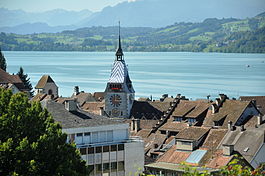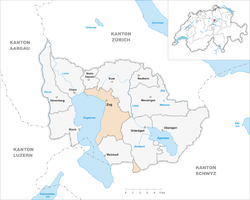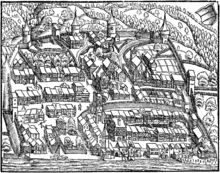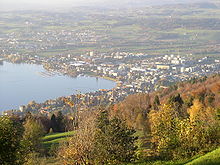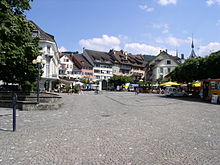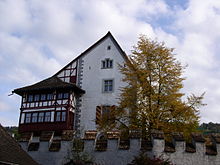- Zug
-
Zug View over Lake Zug with the old city of Zug and the Zytturm Country Switzerland 
DetailsCanton Zug District n.a. 47°10′N 8°31′E / 47.167°N 8.517°ECoordinates: 47°10′N 8°31′E / 47.167°N 8.517°E Population 25,726 (Dec 2009)[1] - Density 735 /km2 (1,904 /sq mi) Area 21.61 km2 (8.34 sq mi)[2] Elevation 425 m (1,394 ft) Postal code 6300 SFOS number 1711 Mayor Dolfi Müller SPS/PSS Surrounded by Cham, Baar, Walchwil, Steinhausen Twin towns Fürstenfeld (Austria) Website www.stadtzug.ch
SFSO statisticsZug (German:
 Zug (help·info) French: Zoug, Italian: Zugo, Romansch: Zug, Latin: named in the 16th century: Tugium), is a German speaking city in Switzerland. The name ‘Zug’ originates from fishing vocabulary; in the Middle Ages it referred to the right to ‘pull up’ fishing nets and hence to the right to fish.
Zug (help·info) French: Zoug, Italian: Zugo, Romansch: Zug, Latin: named in the 16th century: Tugium), is a German speaking city in Switzerland. The name ‘Zug’ originates from fishing vocabulary; in the Middle Ages it referred to the right to ‘pull up’ fishing nets and hence to the right to fish.The city of Zug is located in the Canton of Zug and is its capital. As of 31 December 2009 it has a total population of 25,726 inhabitants.[1]
Contents
History
The town, first mentioned in 1240, was called an "oppidum" in 1242 and a "castrum" in 1255. In 1273, it was bought by Rudolph of Habsburg from Anna, the heiress of Kyburg and wife of Eberhard, head of the cadet line of Habsburg. Part of its territory, the valley of Aegeri, was pledged by Rudolph in 1278 as security for a portion of the marriage gift he promised to Joanna, daughter of Edward I of England. She was betrothed to his son Hartmann, but his death in 1281 prevented the marriage from taking place. The town of Zug was governed by a bailiff, appointed by the Habsburgs, and a council, and was much favored by that family. Several country districts (e.g., Baar, Menzingen, and Aegeri) each had its own "Landsgemeinde" but were governed by one bailiff, also appointed by the Habsburgs; these were known as the "Aeusser Amt," and were always favorably disposed to the Swiss Confederation.
On June 27, 1352, both the town of Zug and the Aeusser Amt entered the Confederation, the latter being received on exactly the same terms as the town, and not, as was usual in the case of country districts, as a subject land; but in September 1352, Zug had to acknowledge its own lords again, and in 1355 was obliged to break off its connection with the league. About 1364, the town and the Aeusser Amt were recovered for the league by the men of Schwyz, and from this time Zug took part as a full member in all the acts of the league. In 1379, the Holy Roman Emperor Wenceslaus exempted Zug from all external jurisdictions, and in 1389 the Habsburgs renounced their claims, reserving only an annual payment of 20 silver marks, which came to an end in 1415. In 1400 Wenceslaus gave all criminal jurisdiction to the town only. The Aeusser Amt, in 1404, then claimed that the banner and seal of Zug should be kept in one of the country districts and were supported in this claim by Schwyz. The matter was finally settled in 1412 by arbitration, and the banner was to be kept in the town. Finally in 1415, the right of electing their landammann was given to Zug by the Confederation, and a share in the criminal jurisdiction was granted to the Aeusser Amt by German king Sigismund.
In 1385, Zug joined the league of the Swabian cities against Leopold III of Austria and shared in the victory of Sempach, as well as in the various Argovian (1415) and Thurgovian (1460) conquests of the Confederates, and later in those of Italy (1512), having already taken part in the occupation of the Val d'Ossola. Between 1379 (Walchwil) and 1477 (Cham), Zug had acquired various districts in its own neighborhood, principally to the north and the west, which were ruled till 1798 by the town alone as subject lands. At the time of the Reformation, Zug clung to the old faith and was a member of the Christliche Vereinigung of 1529. In 1586, it became a member of the Golden League.
In 2001, 11 members of the local (cantonal) parliament and three members of the (cantonal) government were shot and killed in Zug by the assassin Friedrich Leibacher.
The oldest human traces date back to the time of around 14,000 BC. There have been Paleolithic finds on the north bank of Lake Zug, which come from nomadic hunters and collectors. Archaeologists have also been able to prove the existence of over forty lake-shore settlements (pile dwellings), on the shores of Lake Zug, from the epoch of the first settled farmers in the Neolithic period (5,500-2,200 BC). The peak in these lake-shore village settlements was in the period between 3800 and 2450 BC. For the same epoch, the first pre-alpine land use has been proven in Menzingen and in the Ägeri valley. The well-known, historically-researched and interesting lake-shore village, ‘Sumpf’ (the swamp), dated from the late Bronze Age (up until 850 BC). These rich finds result in a quite differentiated picture of life in former times, attractively represented in the Zug Museum for Prehistory. In addition, many traces from the Iron Age (850-50 BC) and the Roman and Celtic-Roman time (from 50 BC) have been discovered.
The City of Zug – Kyburg Foundation
In around 600 AD, Alemannic families and tribes immigrated to the area of present day canton Zug. The name Blickensdorf, and place names with ‘- ikon’ endings, prove this as the first Alemannic living space. The churches of Baar and Risch also date back to the early Middle Ages. The first written document on the area originates from the year 858, and refers to King Ludwig the German giving the farm ‘Chama’ (Cham) to the Zurich Fraumünster convent. At this time, the area of present day Zug belonged to completely different monastic and secular landlords, the most important of whom were the Habsburgs, and who, in 1264, inherited the Kyburg rights and remained a central political power until about 1400. In the course of the high medieval town construction, the settlement of Zug also received a city wall at some point after 1200. The city founders were probably the counts of Kyburg. In 1242, Zug was mentioned for the first time as ‘oppidum’, meaning ‘city’. Research shows that Zug was important as an administrative centre of the Kyburg and the Habsburg office, then as a local market place, and, thereafter, as a stage town for the transport of goods (particularly salt and iron) over the Hirzel hill towards Lucerne. In 1478, the building of a larger city wall began, which increased the city area six-fold - the same year as the building of the late gothic St. Oswald Church began. The building master of the new city wall was Hans Felder from Bavarian Swabia. The ground plan of the city wall is indicative of an ideal symmetric plan of the Renaissance period – something very rare at that time. The overall urban planning implemented in the small town of Zug was modern for its time.
The year 1352 - an episode.
The alliance of the four forest cantons of Uri, Schwyz, Unterwalden and Lucerne with the city of Zurich in 1351 set much in motion. The city of Zug was seen as having Habsburg ties with the cities of Zurich and Lucerne, and therefore had to be conquered. It is likely that this was more for political than economic reasons: the Lucerne market was very important for central Switzerland, but also strongly dependent on the city of Zurich. Zurich initiated a siege on Zug with the federal army in June 1352. Zug surrendered. On 27 June 1352 Zurich, Luzern, Zug, Uri, Schwyz and Unterwalden formed an alliance. Zurich's saw this ‘Zugerbund’ (Zug alliance) as an alliance of convenience. For the city of Zug, little changed, and Zug remained Habsburg. That same year, the Zug alliance was declared invalid by all parties. A period of Schwyz domination then followed. Only gradually did Zug become sovereign and federal.
Simultaneously, Zug expanded its territory, acquiring a number of rural areas in the form of bailiwicks (Walchwil, Cham, Gangolfswil [Risch] Hünenberg and Steinhausen, and Oberrüti, now part of the canton of Aargau). Zug became a confederation in itself - with the ‘city’ and its subject territories, and the three outer (‘free’) municipalities, Ägeri, Menzingen (with Neuheim) and Baar. This problematic dualism dominated until 1798, i.e. until the end of the old confederation, the political structure of the Canton Zug. The unifying element of this miniature confederation was, among others, the rural municipalities and the forty-member city council.
During the turmoil of the Reformation, Zug remained on the Catholic side of central Switzerland and retained the old faith. Warring religious confederates fought at Kappel am Albis (1531) and at Gubel in Menzingen. Its location on the edge of central Switzerland made Zug a confessional border town.
The period up until 1798 was marked by internal political rivalries and turbulence. The invasion of the French troops marked the end of the old order, and with the Helvetic order came a radical political change. Zug became part of the canton Waldstätten, and the cantonal capital for a short time. After a 50-year struggle between federalism and centralism, between confederation and central state, between conservative and liberal-radical vision, in 1848, today’s federal government of Switzerland emerged. Zug was given its current cantonal structure, consisting of eleven local municipalities.
Industrialization and internationalization
Until well into the 19th century, Zug consisted of agricultural land. Actual industrialization began with the entrepreneur Wolfgang Henggeler, who in 1834 built a cotton mill in Unterägeri. This was followed by the two companies in Neuägeri and Baar. In 1866, the American George Ham Page founded the first European condensed milk factory in Cham, which later merged with Nestlé. Industry in Zug was dominated by the company Landis & Gyr, founded in 1896, and now owned by Australian investment company Bayard Capital. The connection to the Swiss railway network in 1864 was important, as was the connection of mountain and valley with an electric tram at the beginning of the 20th Century. In the second half of the century, dynamic expansion took place and Zug became a national and international financial and trading center, aided by its proximity to Zurich, and by an attractive tax policy. In parallel, large industrial and commercial zones evolved; employment increased rapidly; the population rose sharply, and the building boom skyrocketed. Canton Zug catapulted itself into being at the top of the financially strong cantons. And the city today has become, as the British Guardian once wrote, ‘a compass of the global economy’.
Today
Zug is a low tax region, and is headquarters for a number of multinational enterprises.
Zug's best known agricultural product is kirsch.
Situation and features
The lake shore has been embanked and forms a promenade, from which glorious views of the snowy peaks of the Bernese Oberland, as well as of the Rigi and Pilatus, are gained. Towards its northerly end, a monument marks the spot where a part of the shore slipped into the lake in 1887.
The older part of the town is rather crowded together, though only four of the wall towers and a small part of the town walls still survive.
The most striking old building in the town is the parish church of St Oswald (late 15th century), dedicated to St Oswald, king of Northumbria (d. 642), one of whose arms was brought to Zug in 1485. The town hall, also a 15th-century building, now houses the Historical and Antiquarian Museum. There are some quaint old painted houses close by. A little way higher up the hillside is a Capuchin convent in a striking position, close to the town wall and leaning against it. Still higher, and outside the old town, is the fine new parish church of St Michael, consecrated in 1902.
The business quarter is on the rising ground north of the old town, near the railway station. Several fine modern buildings rise on or close to the shore in the town and to its south, whilst to the southwest is a convent of Capuchin nuns, who manage a large girls' school and several other educational establishments.
The Museum of Prehistory Zug houses an important collection of archaeological remains, especially from the late Bronze Age (urnfield culture) settlement of Zug-Sumpf. Many of Catharine II of Russia's relatives descended from Zug and became known as the Volga Germans.
Geography
Zug has an area, as of 2006[update], of 21.7 square kilometers (8.4 sq mi). Of this area, 35.5% is used for agricultural purposes, while 38.1% is forested. Of the rest of the land, 23.8% is settled (buildings or roads) and the remainder (2.6%) is non-productive (rivers, glaciers or mountains).[3]
The canton of Zug is located in the area between the lowlands and the foothills of the Alps. It borders the canton of Schwyz to the south and southeast; the cantons of Lucerne and the ‘Freiamt’ of canton Aargau to the west; and the canton of Zurich to the north and northeast.
Canton Zug’s borders were mainly established by nature itself: the rivers Sihl and Biber, and the Höhronen ridge in the east; the Rossberg mountain in the south, and the Rooterberg mountain, and the river Reuss in the west. Only the 87.5 km-long border between the cantons of Zurich and of Zug is not naturally defined. With its 1580 m peak, the Wildspitz mountain is the highest point in the canton. The lowest point in the north of the canton is at 388 m, at the Rüssspitz (Reussspitz), the confluence of the rivers Lorzen and Reuss.
Diverse Landscape
The canton of Zug is multi-faceted, and this is also reflected in its geographic-topographic diversity. In rough terms, there are two zones, divided by the north-south axis of Lake Zug: the western part with Ennetsee and the plateau of Zug, Steinhausen and Baar; and the eastern part consisting of the hilly and mountaneous zone. In the latter, is the Zugerberg mountain with the Rossberg mountain chain, the valley of Oberaegeri and Unteraegeri, with Lake Aegeri, and the mountain ridge of Höhronen and the countryside of Menzingen and Neuheim.
While the lowland area of Zug, Baar, Steinhausen and Cham are quite urbanized, we see that Ennetsee, with Risch and Hüneneberg, despite a building boom, have kept their rustic side. In Ägeri, Menzingen and Neuheim you find yourself in a completely different landscape and world. As is also the case in Walchwil, the ‘riviera’ of Lake Zug.
Impressive Moraine landscape
The power of the glaciers in the ice age are impressively shown in the lateral moraines of Walchwilerberg mountain and Zugerberg mountain. These are the remaining witnesses of the Reuss glacier. The moraine and drumlin landscape of Menzingen and Neuheim are the result of the convergence of the Reuss glacier and the Linth glacier. The Swiss geologist, Albert Heim (1849–1937), once noted, that ‘this must be the most impressive moraine landscape in Switzerland’. The glaciation of the Zug mountains stopped in around 15,000 BC.
Rivers and Lakes
The Lorze river is the only large river flowing wholly within the canton. The Sihl and Reuss rivers both follow cantonal borders. The Lorze flows from Lake Ägeri through the deep valley of the Lorzentobel to Baar and Lake Zug. In Cham, the Lorze leaves Lake Zug and joins the river Reuss at the afore-mentioned Reussspitz.
Demographics
Zug has a population (as of 31 December 2009) of 25,726.[1] As of 2007[update], 26.4% of the population was made up of foreign nationals. Over the last 10 years the population has grown at a rate of 11.4%. Most of the population (as of 2000[update]) speaks German (81.8%), with Italian being second most common ( 3.8%) and Serbo-Croatian being third ( 3.2%).[3]
In the 2007 federal election the most popular party was the FDP which received 24.9% of the vote. The next three most popular parties were the SVP (23.3%), the Green Party (22%) and the CVP (18.7%).[3]
In Zug about 76% of the population (between age 25-64) have completed either non-mandatory upper secondary education or additional higher education (either university or a Fachhochschule).[3]
Zug has an unemployment rate of 2.28%. As of 2005[update], there were 172 people employed in the primary economic sector and about 51 businesses involved in this sector. 5,821 people are employed in the secondary sector and there are 269 businesses in this sector. 21,445 people are employed in the tertiary sector, with 3,205 businesses in this sector.[3]
Weather
Zug has an average of 136.1 days of rain per year and on average receives 1,224 mm (48.2 in) of precipitation. The wettest month is August during which time Zug receives an average of 158 mm (6.2 in) of precipitation. During this month there is precipitation for an average of 12.7 days. The month with the most days of precipitation is June, with an average of 13.7, but with only 156 mm (6.1 in) of precipitation. The driest month of the year is January with an average of 67 mm (2.6 in) of precipitation over 12.7 days.[4]
Sport
The main sport team is the EV Zug, who plays in the Swiss National League A. They play their home games at the Bossard Arena.
There are also an association football team, Zug 94, which was formed in 1994 and a Rugby Team, Rugby Club Zug, which has a junior team, The Saints Rugby School.
Economy
Today, the small Canton of Zug is a sought-after place of residence, an attractive living space, and a successful business area. The foundations for this were laid in the wise legislation of the 20's in the last century. Like the pioneer Canton Glarus, the Canton of Zug lowered tax charges for holding and domiciled companies. The tax law revision after the Second World War especially benefitted companies.
From poorhouse to the richest canton
The business-friendly tax policy of the canton was effective, and Zug transformed itself from being the poorhouse to the richest canton in Switzerland in 1990. Even in the sixties, Zug had the highest per capita debt, and the average income was below the national average. Today, Zug pays the most into the inter-cantonal financial compensation scheme, NFA (approximately 300 million CHF = 2,042 CHF per capita). Tax expenses are only about half the Swiss average, and the national income per capita is among the highest in Switzerland. In 2010, the gross domestic product per capita in Canton Zug was an estimated 100,000 CHF.
At the end of 2010, there were nearly 30,000 companies in the canton, of which 17,000 were stock exchange-listed companies. Of the approximately 83,000 jobs, nearly three quarters were in the service sector (agriculture: 2.2%, industry: 24.8%, trade and service sector: 73%). Every day about 37,000 people come to Zug to work, 12,000 of whom are from the canton of Lucerne.
Largest private employers
1 Siemens Building Technologies, Zug Building 2‘223 2 Roche Group, Rotkreuz/Cham Pharma/Diagnostics 1‘520 3 V-Zug AG, Zug Household appliances 1‘498 4 Cooperative Migros Luzern, Ebikon Retail trade 1‘124 5 Johnson & Johnson, Zug Pharma/Diagnostics 750 6 Glencore International AG, Baar Commodity Trading 487
As a low tax region, Zug is home to corporate offices for a number of large and small companies. Even though Zug has a population of about 25,000 there are about 24,000 jobs and 12,900[5] registered companies in the city. Some of the registered firms include:
- Transocean,[6] the world's largest offshore drilling contractor.
- Xstrata[7] an international mining company and currently the world's fourth largest producer of copper.
- Biogen Idec[8] a biotechnology company specializing in drugs for neurological disorders, autoimmune disorders and cancer.
- Crypto AG[9] a Swiss company specialising in communications and information security.
- Rothschild Continuation Holdings AG a holding company that controls much of the Rothschild investment bank for the Rothschild family.
- Alliance Boots[10] a retail pharmacist and pharmaceutical wholesaler in several European countries.
- Nord Stream[11] managing a planned natural gas offshore pipeline from Vyborg in Russia to Greifswald in Germany.
- Informa[12]
- Landis+Gyr[13] a company focused on metering and other technologies which deal with management of scarce resources.
- Partners Group[14] a global alternative asset management firm.
- Expert International GmbH[15] a Swiss consumer electronics retail chain with more than 7400 stores.
- Foster Wheeler
- Tata AG[16] the international trading arm of the Tata Group (a $70 billion Indian conglomerate)
Zug as a cultural area
Culture arises from the daily life of living together. The rich variety of the life of Canton Zug is demonstrated in the wide range of cultural activities on offer: music, theatre, art and literature, film and performance; all of indispensable value. The “IG Culture Zug” society currently has some 200 members.
Variety of cultural events
There are three attractively-designed museums in the city: the Museum of Prehistory, which displays archaeological finds from Canton Zug; the castle houses the Museum of Cultural History of the city and Canton Zug, and Zug Art Gallery attracts visitors with its exhibitions: www.museenzug.ch Several municipalities also have their own local museum. The Casino Theatre in Zug and the Zug ‘Burgbachkeller’, along with the ‘Chollerhalle’ cultural centre, are the most famous establishments. The event centres in Baar, Cham and Rotkreuz and the Zug youth scene (Galvanik, Podium Industrie 45) enrich the range of cultural events.
Cultural export No. 1
Zug’s culture also includes the famous Zuger cherry liqueur cake, culinary export hit No. 1 and in demand worldwide. www.zugerkirschtorten.ch. www.zugerchriesi.ch. Not available for export is yet another Zuger constant: the famous sunset, which for author Johannes Mario Simmel, who died in 2009, is the world's most beautiful. And he should know, a world traveller who, for a long time, made Zug his home.
Rich cultural landscape
For modern man, landscape is culture, and Zug has a lot to offer. From Rüssspitz to Wildspitz, from Chiem to Gottschalkenberg, one can discover many scenic highlights; for example, the Zugerberg mountain and the Walchwilerberg Oberallmig - a ridge of fascinating depth of definition, a moor with national cachet. Or Höhronen, with its shady forests and wide footpaths; the winding paths along the river Sihl; through the romantic Lorzentobel to the limestone caves at Höllgrotten, and the castle ruins on Wildenburg mountain. The Choller nature reserve near Lake Zug is also particularly attractive. And this, a mere overview of the many alternatives.
Scenic attractions are one thing, historical and sacred treasures another. The late Gothic church of St. Wolfgang, near Hünenberg, or St. Oswald in Zug, the old town of Zug with the Town Hall and the Clock tower, the ‘Zurlaubenhof’, feudal estate of the family Zurlauben, on the outskirts of the city – all encourage discovery of the unknown. One is beckoned to Ennetsee, to visit the castle of St. Andrew, near Cham, the castle in Buonas, or even the castle ruins of Hünenberg. www.burgen.ch
Part of Zug’s culture is also culinary. Local specialties, in addition to the cherry and the cherry liqueur cake, include the Zug ‘Rötel’, a fine lake charfish, found on many menus. Throughout the canton, gourmet restaurants, restaurants for day-trippers and cafés entice you to eat and relax. www.zug-tourismus.ch
Zug as an educational space
Zug has a long tradition of education. Private schools, like the Montana Institute Zug, on Zugerberg, or the Dr. Pfister Institute AG, Oberägeri supplement the range available. In addition, there are the three former non-state teacher training colleges in Menzingen, Holy Cross in Cham and St. Michael in Zug.
The Zug education system is based on equal abilities, and is broad and diverse in its range - from compulsory primary and secondary school, through optional secondary education and vocational training. Two thirds of young people go into vocational education, connected to an apprenticeship, joining the professional world after the 9th grade of secondary school. The international business community of Zug offers many and varied apprenticeships; and the Zug technical and industrial college, GIBZ, and the business college, KBZ, provide the academic knowledge and skills.
Zug – Canton of tertiary education
Canton Zug has two high schools: the Canton High School in the city of Zug, and the Cantonal School in Menzingen. Also at higher secondary level, is the Vocational School Zug and the Business Studies School, incorporated within the Canton School. Zug is one of the university cantons, with, on the one hand, the University of Teacher Training, PHZ Zug, on the other, a polytechnic for financial services.
There are also six technical colleges (for business, computer science, engineering design, naturopathy and homeopathy, child education, and rescue services).
International Schools
The range of educational institutions is a key factor for location in the globalized world of competition, especially for foreign employees, the so-called ‘Expats’. The four international schools have been developed accordingly, and report a high student intake. 750 children from more than 50 countries attend the International School of Zug alone, at its two campuses in Hünenberg and Baar.
Transportation
Zug acts as an important transportation node.
The SBB-CFF-FFS and other railways link at Zug railway station for Cham - Horgen - Zürich, Steinhausen - Affoltern am Albis, Arth-Goldau - St. Gotthard - Ticino and Italy, and Rotkreuz - Luzern. Zug is a terminal station of the Zürich S-Bahn on the lines S9 and S21.
The A4 motorway and other main roads connect Zug with the rest of the nation.
Water transportation has its node on Lake Zug at Zug.
Heritage sites of national significance
There are a number of Swiss heritage sites of national significance in Zug. These include two libraries, the Library of the former Capuchin monastery and the library of the parish church of St. Michael. One archeological site, the Sumpf a late Bronze Age lake shore settlement, is included, as are three museums; the Burg (Castle museum), Kunsthaus (Art museum) and Museum für Urgeschichte (Museum for ancient history). There are three archives that are included in the list; Bürgerarchiv Zug (Citizen's archive of Zug), Staatsarchiv Zug (State/Canton of Zug archive) and the Unternehmensarchiv der Landis & Gyr AG (Landis & Gyr AG company archives). The rest of the sites are the Catholic Church of St. Oswald with Charnel house, the Seminary of St. Michael, the city walls and several buildings in the old city of Zug.[17]
The prehistoric settlements at Oterswil/Insel Eielen, Riedmatt and Sumpf are part of the Prehistoric Pile dwellings around the Alps a UNESCO World Heritage Site.[18]
Media Attention
The town became noticed in American media when CBS 60 minutes made a critical piece on the town being the "safe-haven" for American corporations.[19]
References
- ^ a b c Swiss Federal Statistical Office, MS Excel document – Bilanz der ständigen Wohnbevölkerung nach Kantonen, Bezirken und Gemeinden (German) accessed 25 August 2010
- ^ Arealstatistik Standard - Gemeindedaten nach 4 Hauptbereichen
- ^ a b c d e Swiss Federal Statistical Office accessed 22-Sep-2009
- ^ "Temperature and Percipitation Average Values-Table, 1961-1990" (in German, French, Italian). Federal Office of Meteorology and Climatology - MeteoSwiss. http://www.meteoswiss.admin.ch/web/de/klima/klima_schweiz/tabellen.html. Retrieved 8 May 2009., the weather station elevation is 435 meters above sea level.
- ^ Zug City website - Numbers (German) accessed 9 March 2011
- ^ Transocean website accessed 13 May 2010
- ^ Xstrata website accessed 13 May 2010
- ^ Biogenidec website accessed 13 May 2010
- ^ Crypto AG website accessed 13 May 2010
- ^ Alliance Boots Website accessed 13 May 2010
- ^ Nord Stream website accessed 13 May 2010
- ^ "Global Contacts." Informa. Retrieved on 4 February 2011. "Head Office Gubelstrasse 11 CH-6300 Zug Switzerland"
- ^ Landis+Gyr website accessed 13 May 2010
- ^ Partners Group website accessed 13 May 2010
- ^ Expert website accessed 13 May 2010
- ^ Tata Group website accessed 28 November 2010
- ^ Swiss inventory of cultural property of national and regional significance 21.11.2008 version, (German) accessed 22-Sep-2009
- ^ UNESCO World Heritage Site - Prehistoric Pile dwellings around the Alps
- ^ CBS news, 60 Minutes report
 This article incorporates text from a publication now in the public domain: Chisholm, Hugh, ed (1911). Encyclopædia Britannica (11th ed.). Cambridge University Press. Please update as needed.
This article incorporates text from a publication now in the public domain: Chisholm, Hugh, ed (1911). Encyclopædia Britannica (11th ed.). Cambridge University Press. Please update as needed.
External links
- http://www.stadtzug.ch (German) Official city website
- Pictures Zug
- http://www.zytturm.com/ Pictures and history Zytturm (klick "english" and "clocktower")
Baar | Cham | Hünenberg | Menzingen | Neuheim | Oberägeri | Risch | Steinhausen | Unterägeri | Walchwil | Zug

Capitals of Swiss cantons Categories:- Municipalities of the canton of Zug
- Municipalities of Switzerland
- Cantonal capitals of Switzerland
- Cities in Switzerland
- Canton of Zug
- Imperial free cities
Wikimedia Foundation. 2010.

